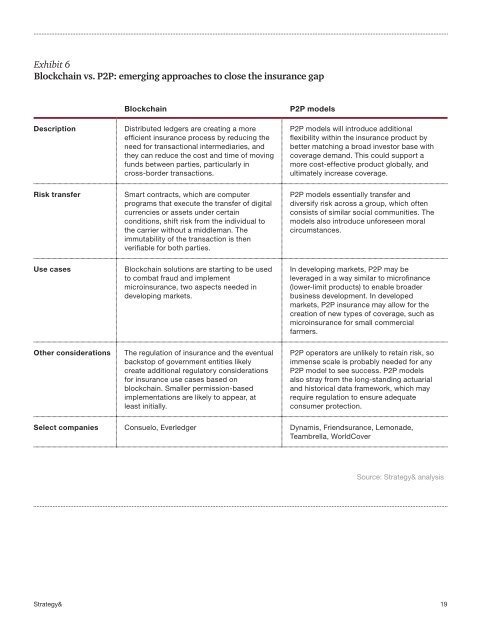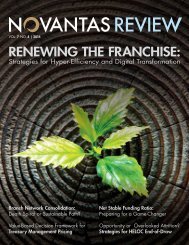The un(der)banked is FinTech’s largest opportunity
DeNovo-Quarterly-Q2-2016.pdf?utm_content=buffer9dd60&utm_medium=social&utm_source=twitter
DeNovo-Quarterly-Q2-2016.pdf?utm_content=buffer9dd60&utm_medium=social&utm_source=twitter
Create successful ePaper yourself
Turn your PDF publications into a flip-book with our unique Google optimized e-Paper software.
Exhibit 6<br />
Blockchain vs. P2P: emerging approaches to close the insurance gap<br />
Description<br />
Blockchain<br />
D<strong>is</strong>tributed ledgers are creating a more<br />
efficient insurance process by reducing the<br />
need for transactional intermediaries, and<br />
they can reduce the cost and time of moving<br />
f<strong>un</strong>ds between parties, particularly in<br />
cross-bor<strong>der</strong> transactions.<br />
P2P models<br />
P2P models will introduce additional<br />
flexibility within the insurance product by<br />
better matching a broad investor base with<br />
coverage demand. Th<strong>is</strong> could support a<br />
more cost-effective product globally, and<br />
ultimately increase coverage.<br />
R<strong>is</strong>k transfer<br />
Smart contracts, which are computer<br />
programs that execute the transfer of digital<br />
currencies or assets <strong>un</strong><strong>der</strong> certain<br />
conditions, shift r<strong>is</strong>k from the individual to<br />
the carrier without a middleman. <strong>The</strong><br />
immutability of the transaction <strong>is</strong> then<br />
verifiable for both parties.<br />
P2P models essentially transfer and<br />
diversify r<strong>is</strong>k across a group, which often<br />
cons<strong>is</strong>ts of similar social comm<strong>un</strong>ities. <strong>The</strong><br />
models also introduce <strong>un</strong>foreseen moral<br />
circumstances.<br />
Use cases<br />
Blockchain solutions are starting to be used<br />
to combat fraud and implement<br />
microinsurance, two aspects needed in<br />
developing markets.<br />
In developing markets, P2P may be<br />
leveraged in a way similar to microfinance<br />
(lower-limit products) to enable broa<strong>der</strong><br />
business development. In developed<br />
markets, P2P insurance may allow for the<br />
creation of new types of coverage, such as<br />
microinsurance for small commercial<br />
farmers.<br />
Other consi<strong>der</strong>ations<br />
<strong>The</strong> regulation of insurance and the eventual<br />
backstop of government entities likely<br />
create additional regulatory consi<strong>der</strong>ations<br />
for insurance use cases based on<br />
blockchain. Smaller perm<strong>is</strong>sion-based<br />
implementations are likely to appear, at<br />
least initially.<br />
P2P operators are <strong>un</strong>likely to retain r<strong>is</strong>k, so<br />
immense scale <strong>is</strong> probably needed for any<br />
P2P model to see success. P2P models<br />
also stray from the long-standing actuarial<br />
and h<strong>is</strong>torical data framework, which may<br />
require regulation to ensure adequate<br />
consumer protection.<br />
Select companies Consuelo, Everledger Dynam<strong>is</strong>, Friendsurance, Lemonade,<br />
Teambrella, WorldCover<br />
Source: Strategy& analys<strong>is</strong><br />
Strategy&<br />
19




